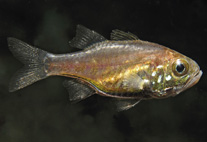Abstract
The second- and third instar larvae of the cliff water beetle Aspidytes wrasei Balke, Ribera & Beutel, 2003 are studied for the first time with special emphasis on morphometry and chaetotaxy. A review of the characters useful in the identification of larvae of Aspidytes Ribera, Beutel, Balke & Vogler, 2002 is presented. Confirming previous findings, larvae of this genus are unique within Hydradephaga in the dorsally oriented spiracles on the abdominal segment VIII of instars II and III. The inclusion of Aspidytidae within the superfamily Dytiscoidea is reinforced by the following putative synapomorphies: presence of pore PAp, proximal insertion of pore ANg, apical or subapical insertion of seta MX8, presence of pore LAd, and distal insertion of seta CO6. Larvae of A. wrasei differ from those of A. niobe Ribera, Beutel, Balke & Vogler, 2002 in several significant characters that may indicate that both species have a long history of independent evolution.

